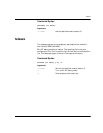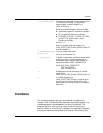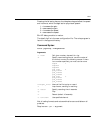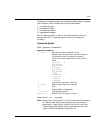
trombone
November 2009 165
trombone
The trombone program sets up a two channel (trombone) call
transfer. After the two channels have been connected together, the
trombone program records speech from one of the callers. The
program starts by waiting for an inbound call on the primary
channel. When an inbound call is detected, the application answers
and plays a welcome voice prompt to the caller. After playing the
-m b_channel_mode The channel mode used if the protocol can do 1
or 2 B-channel transfer. If the protocol
supports both, transfer capability is
LINE_XFER_ALL.
Different protocols support different modes:
Hookflash supports 1 B-channel transfers.
RLT supports 2 B-channel transfers.
ETSI BRI, ETSI PRI, T1-ISDN, NTT BRI,
and NTT PRI support both 1 and 2
B-channel transfers.
Values: 1, 2
Note: This option does not support the
LINE_XFER_TWO_CHAN_NEEDS_NAILUP
transfer capability.
-s SUPERVISED mode
prompt_file
Turns on supervised mode.
Value: a valid prompt file.
-t line_state Transfer is completed at different states while
making the call in unsupervised mode. In
supervised mode, the only state allowed to
complete transfer is BST_CONNECTED.
Value: BST_DIAL_COMPLETE
BST_ALERTING
BST_CONNECTED
-d Disables auto switch connection if transfer
capability is
LINE_XFER_TWO_CHAN_NEEDS_NAILUP.
-h If transfer capability is
LINE_XFER_TWO_CHAN, this option puts
the first call on the first bchannel on hold
before making the enquiry call on the second
bchannel.


















